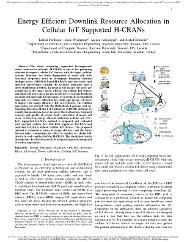| dc.contributor.author | Ferdouse, Lilatul | |
| dc.contributor.author | Woungang, Isaac W. | |
| dc.contributor.author | Anpalagan, Alagan S. | |
| dc.contributor.author | Erküçük, Serhat | |
| dc.date.accessioned | 2021-05-28T17:51:38Z | |
| dc.date.available | 2021-05-28T17:51:38Z | |
| dc.date.issued | 2021 | |
| dc.identifier.issn | 0018-9545 | en_US |
| dc.identifier.uri | https://hdl.handle.net/20.500.12469/4035 | |
| dc.description.abstract | The cloud computing supported heterogeneous cloud radio access network (H-CRAN) is one of the promising solutions to support cellular IoT devices with the legacy cellular systems. However, the dense deployment of small cells with fractional frequency reuse in orthogonal frequency division multiple access (OFDMA) based H-CRANs increases intra- and inter-cell interference, turning the resource allocation into a more challenging problem. In general, the macro cell users are considered as the legacy users, whereas the cellular IoT devices and small cell users share the macro cell users resource blocks in an underlaid approach. In this paper, we investigate an underlaid approach of resource allocation for small and macro cell users to improve the energy efficiency (EE) in H-CRANs. The solution approaches are derived with the Dinkelbach, Lagrange and Alternating Direction Method of Multipliers (ADMM) methods by considering maximum power, resource block allocation, fronthaul capacity and quality of service (QoS) constraints of macro cell users. A two-step energy efficient underlaid cellular IoT (UCIoT) supported H-CRAN method is proposed and evaluated with overlaid cellular IoT (OC-IoT) supported H-CRAN and underlaid H-CRAN without cellular IoT devices. The proposed method is evaluated in terms of energy efficiency and the Jain's fairness index, considering the effect of number of cellular IoT density in each small cell of the H-CRAN. The simulation results demonstrate the effectiveness of the proposed approach compared to earlier approaches. | en_US |
| dc.language.iso | eng | en_US |
| dc.publisher | Institute of Electrical and Electronics Engineers Inc. | en_US |
| dc.rights | info:eu-repo/semantics/closedAccess | en_US |
| dc.subject | Cellular IoT Systems | en_US |
| dc.subject | Energy Efficiency | en_US |
| dc.subject | H-CRAN | en_US |
| dc.subject | OFDMA | en_US |
| dc.subject | Power Allocation | en_US |
| dc.subject | Resource Block Allocation | en_US |
| dc.title | Energy Efcient Downlink Resource Allocation in Cellular IoT Supported H-CRANs | en_US |
| dc.type | article | en_US |
| dc.relation.journal | IEEE Transactions on Vehicular Technology | en_US |
| dc.identifier.wos | WOS:000671544000050 | en_US |
| dc.identifier.doi | 10.1109/TVT.2021.3076825 | en_US |
| dc.identifier.scopus | 2-s2.0-85105061116 | en_US |
| dc.institutionauthor | Erküçük, Serhat | en_US |
| dc.relation.publicationcategory | Makale - Uluslararası Hakemli Dergi - Kurum Öğretim Elemanı | en_US |
















